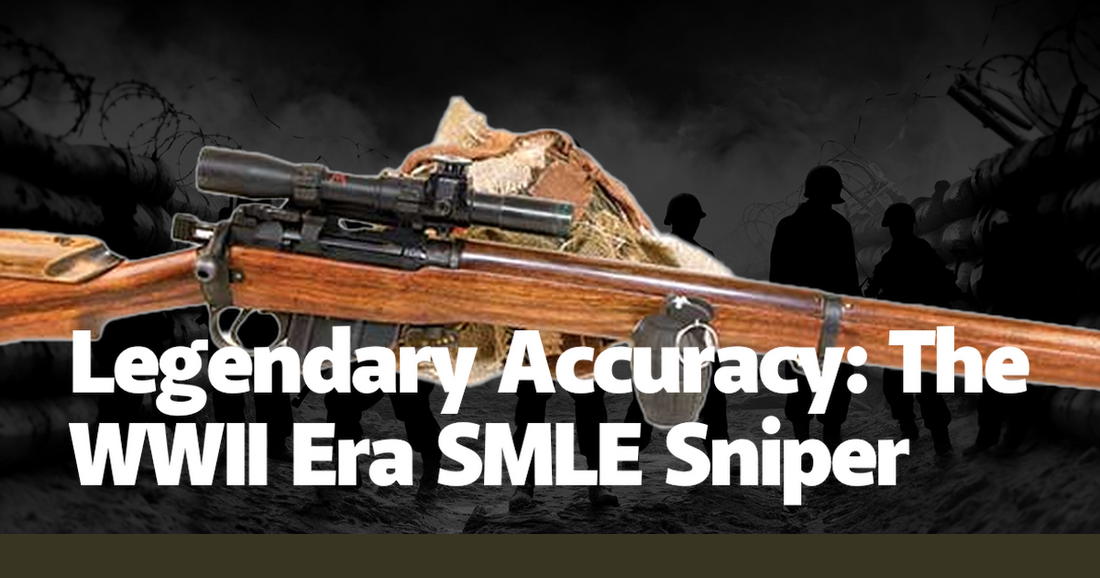The Short Magazine Lee-Enfield (SMLE) sniper rifle is a storied weapon, synonymous with unparalleled accuracy and reliability during World War II. Its legacy is etched in the annals of military history, a testament to the engineering prowess and battlefield effectiveness that characterized British arms. The SMLE, particularly in its sniper configuration, was more than just a tool of war; it was a symbol of precision and lethality. The rifle's design, featuring a robust bolt-action mechanism and a ten-round magazine, allowed for rapid and sustained fire, a crucial advantage in the heat of battle. But it was the meticulous craftsmanship and attention to detail in the sniper variants that truly set the SMLE apart.
One of the most compelling aspects of the SMLE sniper was its optical sighting system. The No. 32 telescopic sight, developed specifically for the SMLE, provided a level of clarity and magnification that was unmatched at the time. This scope, with its fine crosshairs and precise adjustments, allowed snipers to engage targets at distances previously thought impractical. Anecdotes from the front lines often highlight the effectiveness of this combination. For instance, British snipers in the North African campaign reported hitting targets at over 600 yards, a feat that was as much a testament to their skill as to the rifle's capabilities.
The SMLE sniper's performance in various theaters of war further solidified its reputation. In the dense forests of Europe, where visibility was limited and engagements were often at closer ranges, the rifle's rapid rate of fire and accuracy proved invaluable. Snipers could quickly acquire and engage multiple targets, providing critical support to infantry units. In the vast expanses of the Eastern Front, where long-range engagements were more common, the SMLE's ability to deliver precise shots at extended distances made it a favored weapon among Allied marksmen. The adaptability of the SMLE to different combat environments underscored its versatility and effectiveness.
The human element behind the SMLE sniper cannot be overlooked. The training and skill of the snipers who wielded this weapon played a significant role in its legendary status. British sniper training during WWII was rigorous, focusing on marksmanship, fieldcraft, and camouflage. Trainees were taught to blend into their surroundings, to move silently and unseen, and to make every shot count. Stories of snipers like Sergeant Harry Furness, who famously used his SMLE to devastating effect during the Battle of Monte Cassino, illustrate the deadly efficiency of these soldiers. Furness's ability to pick off enemy officers and disrupt German operations was a direct result of his training and the reliability of his rifle.
The psychological impact of the SMLE sniper on enemy forces was profound. The knowledge that a skilled marksman could be lurking anywhere, capable of delivering a fatal shot from an unseen position, instilled a sense of dread among Axis soldiers. This fear was not unfounded; the precision and lethality of the SMLE sniper forced enemy units to alter their tactics, often slowing their advance and making them more cautious. The psychological warfare waged by snipers using the SMLE was a crucial, if intangible, aspect of its effectiveness.
In terms of engineering, the SMLE sniper was a marvel of wartime innovation. The rifle's design was a product of continuous improvement and adaptation. The addition of the No. 32 scope, the fine-tuning of the trigger mechanism, and the careful selection of high-quality barrels all contributed to its exceptional performance. Each rifle was hand-fitted and tested, ensuring that it met the stringent standards required for sniper use. This level of craftsmanship was rare in mass-produced wartime equipment, highlighting the importance placed on snipers and their role in the conflict.
The legacy of the SMLE sniper extends beyond WWII. Its influence can be seen in the design of modern sniper rifles, many of which borrow elements from its construction and sighting systems. The principles of accuracy, reliability, and adaptability that defined the SMLE continue to be guiding tenets in the development of precision firearms today. Collectors and historians alike revere the SMLE sniper, not just as a piece of military hardware, but as a symbol of the skill and bravery of the soldiers who used it.
In conclusion, the WWII era SMLE sniper rifle remains a legendary figure in the history of military firearms. Its combination of engineering excellence, battlefield performance, and the skill of the snipers who wielded it created a weapon of unparalleled accuracy and effectiveness. The stories and achievements of those who used the SMLE sniper serve as a powerful reminder of the impact that precision and skill can have in warfare. As we reflect on the legacy of the SMLE, we honor not just a rifle, but the men who, through their training and courage, made it a legend.

